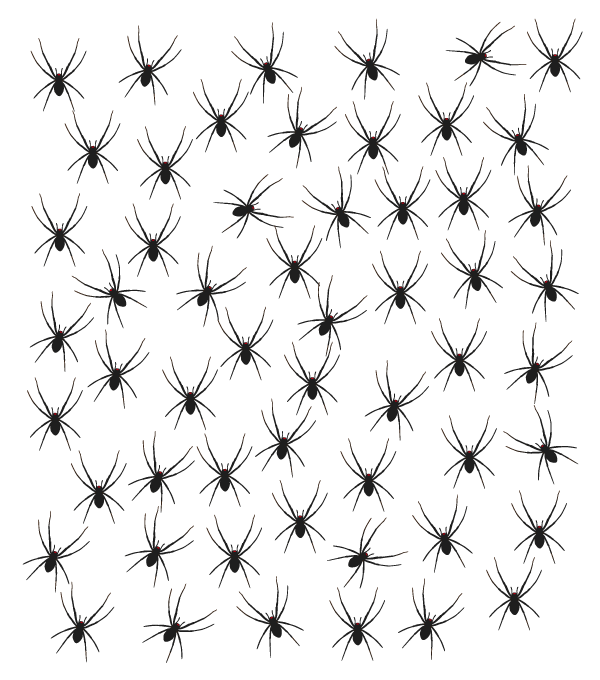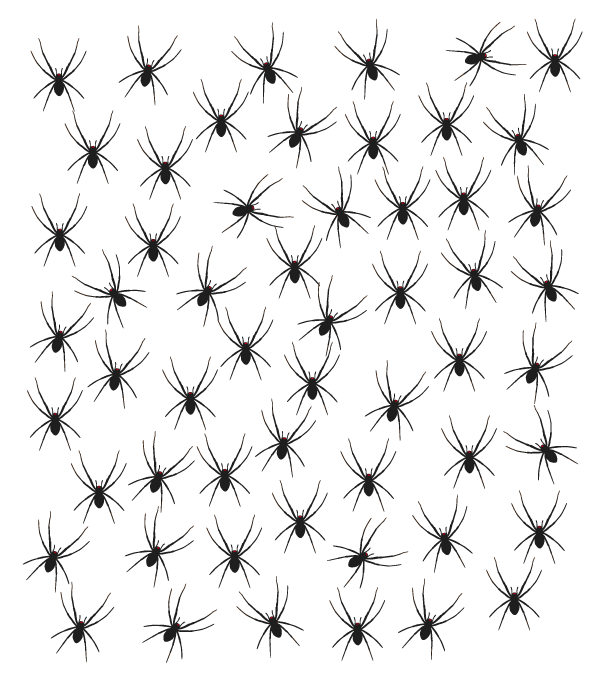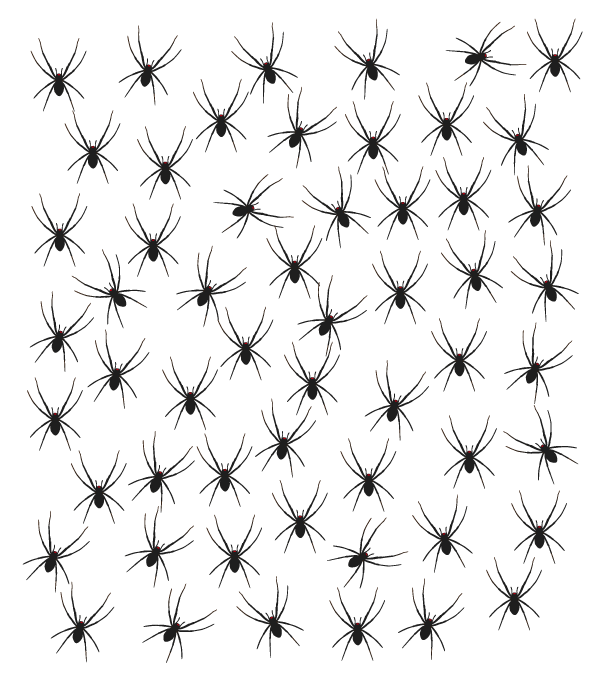Estimating a quantity means guessing how many objects or people there are in a set without counting them.
In the following figure, we can see that there are lots of spiders.
Before counting them one by one, we can estimate how many we think there are. In this image, it looks like there are around 50 spiders. That’s our estimate.
Now, we count them one by one. We get a total of 56 spiders. This is the exact value.
Our estimate is fairly close to the exact value. So, we made a good estimate.

We can also estimate a measurement of length, time, or temperature.
Here are a few examples:
-
An ice cream cone is about 10 cm tall.
-
You’re hungry and know that lunch will be ready soon, so it must be around noon.
-
It’s warm enough that I can go outside in a bathing suit, so the temperature must be around 25°C.
Approximating the result of a calculation means finding a number close to the exact answer.
For example, to find the approximate result of a complex addition problem, we can round the numbers before adding them.
To learn how to round a number, read the concept sheet Rounding a Number.
Stacy picks pears with her grandmother. Stacy picked 316 pears and her grandmother picked 588. Approximately how many pears did Stacy and her grandmother pick in total?
Before adding the two numbers, we’ll round them to the nearest hundred.
|
316 is between 300 and 400, but closer to 300, so we know that 316 rounded to the nearest hundred is 300. |
|
588 is between 500 and 600, but closer to 600, so we know that 588 rounded to the nearest hundred is 600. |
|
316 + 588 |
Answer: Stacy and her grandmother picked approximately 900 pears in total.
An approximation is a value close to a real value that is found by rounding or estimating.
-
Rounding means giving a value close to a known number.
-
Estimating means determining a value close to an unknown number.
In the following figure, we can see that there are lots of spiders.
Before counting them one by one, we can estimate how many we think there are. In this image, it looks like there are around 50 spiders. That’s our estimate.
Now, we count them one by one. We get a total of 56 spiders. This is the exact value.
We can then round this number to the nearest ten. So, we can say there are approximately 60 spiders in the picture. This is a rounded number.
The numbers 50 and 60 are two approximations of the exact number of spiders.

We can also estimate a measurement of length, area, volume, mass, time or temperature.
Here are a few examples:
-
An ice cream cone is about 10 cm tall.
-
You’re hungry and know that lunch will be ready soon, so it must be around noon.
-
It’s warm enough that I can go outside in a bathing suit, so the temperature must be around 25°C.
We can also approximate the result of a calculation.
For example, to find the approximate result of a complex addition problem, we can round the numbers before adding them.
A music festival had 91 627 attendees on Day 1 and 47 945 attendees on Day 2. Approximately how many people went to the festival in total?
Before adding the two numbers, we’ll round them to the nearest ten thousand.
|
91 627 is between 90 000 and 100 000, but closer to 90 000, so we know that 91 627 rounded to the nearest ten thousand is 90 000. |
|
47 945 is between 40 000 and 50 000, but closer to 50 000, so we know that 47 945 rounded to the nearest ten thousand is 50 000. |
|
91 627 + 47 945 |
Answer: In total, approximately 140 000 spectators attended the festival.
An approximation is a value close to a real value that is found by rounding or estimating.
-
Rounding means giving a value close to a known number.
-
Estimating means determining a value close to an unknown number.
In the following figure, we can see that there are lots of spiders.
Before counting them one by one, we can estimate how many we think there are. In this image, it looks like there are around 50 spiders. That’s our estimate.
Now, we count them one by one. We get a total of 56 spiders. This is the exact value.
We can then round this number to the nearest ten. So, we can say there are approximately 60 spiders in the picture. This is a rounded number.
The numbers 50 and 60 are two approximations of the actual number of spiders.

We can also estimate a measurement of length, area, volume, capacity, mass, angle, time, or temperature.
Here are a few examples:
-
An ice cream cone is about 10 cm tall.
-
You draw an acute angle that is a little less than 90°. It’s approximately 80°.
-
You’re hungry and know that lunch will be ready soon, so it must be around noon.
-
It’s warm enough that I can go outside in a bathing suit, so the temperature must be around 25°C.
We can also approximate the result of a calculation.
For example, to find the approximate result of a complex addition problem, we can round the numbers before adding them.
-
When the result of an operation is exact, we use the symbol “=”.
-
When the result of an operation is approximate, we use the symbol “≈”, which means “approximately equal to.”
A music festival had 91 627 attendees on day 1 and 47 945 attendees on day 2. Approximately how many people went to the festival in total?
Before adding the two numbers, we’ll round them to the nearest ten thousand.
Rounding 91 627.
|
The digit in the ten thousands position in 91 627 is 9. |
|
The digit to the right of the 9 in 91 627 is a 1, so we know that the 9 stays the same. |
|
91 627 rounded to the nearest ten thousand is 90 000. |
Rounding 47 945.
|
The digit in the ten thousands position place in 47 945 is 4. |
|
The digit to the right of the 4 in 47 945 is a 7, so we know that we have to add 1 to the digit 4. 4 + 1 = 5 |
|
47 945 rounded to the nearest ten thousand is 50 000. |
Add the two rounded numbers.
91 627 + 47 945 ≈ 90 000 + 50 000 ≈ 140 000
Answer: In total, approximately 140 000 spectators attended the festival.
On his last shopping trip, Charlie bought a pair of sneakers for $120.25 and a pair of jeans for $45.89. Approximately how much money did he spend in total?
Before adding the two numbers, we’ll round them to the nearest unit.
Rounding 120.25.
|
The digit in the ones position place in 120.25 is a 0. |
|
The digit to the right of the 0 in 120.25 is a 2, so we know that the 0 stays the same. |
|
120.25 rounded to the nearest unit is 120.00, or simply 120. |
Rounding 45.89.
|
The digit in the ones position in 45.89 is 5. |
|
The digit to the right of the 5 in 45.89 is an 8, so we know that we have to add 1 to the digit 5. 5 + 1 = 6 |
|
45.89 rounded to the nearest unit is 46.00, or simply 46. |
Add the two rounded numbers.
120.25 + 45.89 ≈ 120 + 46 ≈ 166
Answer: Charlie spent a total of approximately $166